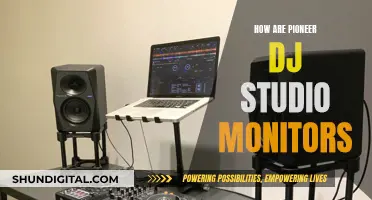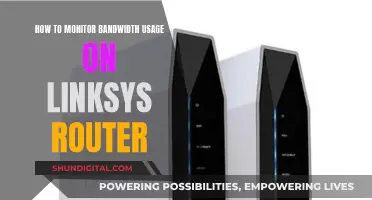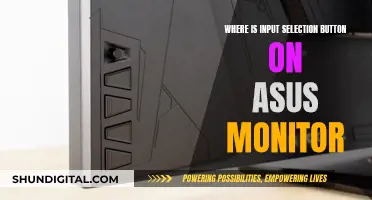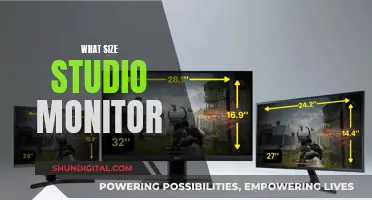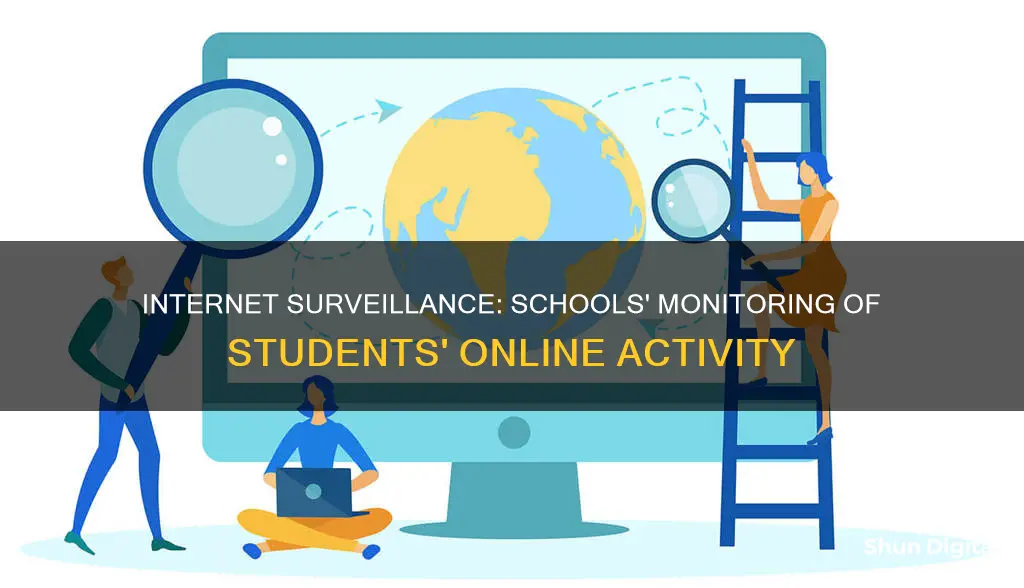
Schools can monitor students' internet usage, and this has become increasingly common since the Covid-19 pandemic pushed education online. Schools can track students' online activity when they are connected to the school's Wi-Fi network, including their location and the websites they visit. They can also implement classroom management software on school laptops to monitor internet history and use proctoring apps to watch students during schoolwork and tests. While schools cannot track students' online activity through Wi-Fi when they are at home, they may still be able to monitor them through proctoring apps or if the student is logged into a school account. To prevent schools from monitoring their activity, students can use a VPN to encrypt their traffic and hide their online activity.
| Characteristics | Values |
|---|---|
| Can schools monitor internet usage? | Yes |
| Can schools monitor usage outside of school? | Yes, if the student is logged into their school account |
| Can schools see what students are doing on their personal devices? | Yes, if the student is connected to the school's Wi-Fi |
| Can schools see what students are doing when not connected to school Wi-Fi? | No, but if proctoring apps are installed, schools may be able to monitor students via camera or keystrokes |
| Can schools see what sites students have visited? | Yes, if the sites are not secured with HTTPS |
| Can schools see what students have looked at on unsecure sites? | Yes |
| Can schools see where students are? | Yes, if the student is connected to the school's Wi-Fi |
| Can schools monitor email correspondence? | Yes, if the school hosts its email system |
| Can schools block VPN usage? | Yes |
| Can schools see student screens? | Yes, if the connection is unsecured |
What You'll Learn

Schools can monitor students' internet usage on campus
Additionally, schools often implement classroom management software on school-issued laptops, which allows them to monitor internet history and computer usage. This was revealed in a study by privacy advocates Big Brother Watch, which found that over 1,000 schools in the UK had such software installed on students' devices. The use of these monitoring tools has become more prevalent since the start of the COVID-19 pandemic, with schools utilising proctoring apps to supervise students during remote learning and exams.
Schools can also track students' locations on campus through their Wi-Fi-connected mobile devices. This technology can pinpoint the exact room a student is in, and there is potential for this to be used to monitor individual student movements and even reflect time spent off-campus in grades. When combined with CCTV surveillance, schools can gain a comprehensive understanding of students' physical locations.
While schools have justifiable reasons for monitoring internet usage, such as ensuring a safe learning environment, it is important to acknowledge the potential for overreach and invasion of privacy. Students should be aware of their schools' privacy practices and the extent of data gathering. To enhance their privacy, students can use Virtual Private Networks (VPNs) to encrypt their internet traffic and prevent admins from viewing their online activities.
Monitoring Power Usage: A Comprehensive Guide to Energy Efficiency
You may want to see also

Schools can see what students do on their phones or laptops
Schools can monitor what students do on their phones or laptops, but this ability is dependent on several factors. Firstly, if the device is owned by the school, it likely has pre-installed software that allows the school to monitor the device's activity, regardless of whether it is connected to the school's network or a private home network. This software can track internet history, app usage, and possibly email or document access.
Secondly, if a student uses the school's Wi-Fi network, the school can potentially monitor their online activities, including websites visited and online services used. This is because schools often employ network monitoring tools to ensure students are accessing appropriate content and to protect them from harmful material. However, this monitoring is limited to the duration of the device's connection to the school's Wi-Fi.
Thirdly, if a student is logged into their school account on a personal device, the school may be able to track their activity on that device, even when connected to a private home network. This is because the school can monitor activity on its servers, and accessing a school account would involve connecting to a school-controlled server.
It is important to note that schools primarily monitor students' online activities for safety and security reasons. They aim to prevent students from accessing harmful or inappropriate content, protect them from cyberbullying and online victimization, and avoid legal repercussions for failing to provide a safe learning environment.
Students concerned about their privacy can use privacy tools like VPNs, proxies, or the Tor network to shield their online activities from school monitoring. These tools mask IP addresses and encrypt internet traffic, making it difficult for schools to track students' online activities.
Monitoring Bandwidth Usage: Strategies for Effective Network Management
You may want to see also

Schools can track students' locations through Wi-Fi usage
Schools can track students' locations through their Wi-Fi usage. While the extent of this tracking varies, it is almost certain that students' time in classrooms, both online and in-person, is being monitored. This is done through Wi-Fi usage trackers, which can identify who you are, where you are, and what you're doing online.
In Australia, several universities were found to be tracking the movement of students around campus through their Wi-Fi-connected mobile phones. They could even tell which room the students were in. While this tracking currently only monitors students' movements in general, the technology could be used to identify activity on an individual level. For example, it could check how much time a student spends off-campus and reflect this in their grades.
When combined with CCTV camera surveillance, this technology can be used to determine a student's physical location at all times, which is pretty invasive. However, it's important to note that schools cannot track students' online activity through Wi-Fi when they are at home.
Students can take steps to protect their privacy and security while on campus. Getting a good VPN will hide their internet traffic from school Wi-Fi admins. Additionally, students can separate their private and academic correspondence, using an email provider that prioritizes privacy and security.
Monitoring Energy Usage: A Guide to Understanding Your Consumption
You may want to see also

Schools can monitor students' online activity off-campus
Additionally, if students are logged into their school account on their personal devices, the school may be able to track their online activity. This includes monitoring their Google Drive activity and any sites visited on the school server. However, the school cannot see their web history unless they are logged into their school account.
Furthermore, if students have installed any school-developed software or apps on their personal devices, the school may be able to monitor their activity through these means. This could include proctoring apps, which are often used to "watch" students during schoolwork or tests.
It is important to note that monitoring students' online activity raises concerns about student privacy and equity. Wealthier students with personal devices are less likely to be subjected to the same level of monitoring as students in higher-poverty districts who rely on school-issued devices. Additionally, more than 60% of parents expressed concern that the data collected could be used for disciplinary purposes or have unintended consequences, such as outing LGBTQ+ students.
Water Usage Monitoring: A Standard Practice in Hotels?
You may want to see also

Schools can monitor students' emails
Schools may use automated monitoring systems that flag certain keywords or phrases, such as those related to self-harm, bullying, or violence. This allows schools to identify and address potential issues promptly. For example, a student's parent was contacted after the student sent an email mentioning self-harm. In another instance, a student was pulled out of class after writing about suicide in an English assignment.
While some argue that monitoring helps maintain a safe environment and can even save lives, others raise concerns about student privacy and the potential for misunderstanding or over-surveillance. There may be a "chilling effect" on students' self-expression and exploration, especially for marginalised groups. Additionally, while schools often justify monitoring as a way to keep students safe, there is limited evidence that it effectively reduces violence or self-harm.
To avoid school monitoring, students can use non-school email accounts and avoid school networks and devices. However, it is essential to respect the rules and policies set by schools regarding acceptable usage.
Monitoring GPU Usage: A Comprehensive Guide to Tracking Performance
You may want to see also
Frequently asked questions
Yes, if you are connected to the school's Wi-Fi, your school can see which websites you've visited. If the sites are not secured with HTTPS, they can also see what you've looked at.
Your school cannot track your online activity through Wi-Fi when you're at home. However, if your device has a proctoring app installed, your school might be able to watch or listen in via your camera or microphone, or monitor your keystrokes.
Yes, your school can see your browsing history if you use a school laptop, especially if it is logged in as an administrator. They can also view the cache of websites visited during that session.
No, incognito mode does not hide your browsing history from school administrators. They can still see the sites you visit and when, just as they would in normal browser viewing modes.




